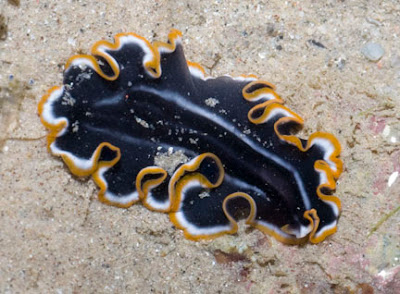St. John's Island lies just 15 minutes off the main business district and has reefs, seagrasses, sandy and rocky shores and rare mangrove trees too. As we arrive on the shore, serious wet weather was building up on the mainland.
But we had a great survey and I had a particularly sluggy night.
To catch the last of the daylight, I quickly headed around the point to have a look at the Critically Endangered Nyireh (Xylocarpus rumphii). I have only seen these trees here and at Sentosa. The big old gnarled mother tree seems alright although it seems to have less leaves.
While one of the two younger trees nearby seems fine, the smaller one seems to have been affected by a recent landslide and lost half of its branches, on the side facing the cliff. Oh dear. I hope it will be ok.
Despite the thick carpet of Sargassum seaweed (Sargassum sp.) covering the reefs, I managed to sneak a peek at some of the corals there. A good variety of corals can be found here and I didn't come across any that were bleaching, although some were rather pale.
I also saw a few leathery soft corals, and they too were not bleaching.
Oh dear, a lost 'Nemo'. I saw this False clown anemonefish (Amphiprion ocellaris) swimming about and I couldn't see any anemone nearby. Sometimes, I've seen anemonefishes sheltering in a pool at low tide, away from their anemone which is high and dry. Hopefully, this fish will be able to get back to its anemone home when the tide rises.
There were many other different fishes too. Some were hiding among the Sargassum seaweed. Others were well camouflaged among sponges.
How nice to come across this Orange-white black flatworm. So far, we've only seen this on more remote shores.
There were lots of Horn-eyed ghost crabs (Ocypode cerathophthalmus) on the shore, foraging among the seaweeds. This one has found a fish that is almost as big as itself!
St. John's has lovely natural rocky shores full of life. Among them, lots of fat juicy Onch slugs (Family Onchidiidae). These slugs 'breathe' through their backside! They have modified gills, a section of the mantle cavity modified as a lung to breath air. The opening to this cavity is at their rear ends.
As it was difficult to safely survey the Sargassum covered so I spent some time looking at the small patches of Spoon seagrasses (Halophila ovalis) in the lagoons. All kinds of animals can be found here! Lots of little crabs, snails and even small Common sea stars (Archaster typicus).
I seemed to have luck with slugs today. I saw two of these tiny Bushy slugs (Polybranchia orientalis). These sap sucking slugs are usually only common on our Northern shores. So far, in the South, I've only seen them on Cyrene Reef.
Another slug I found was this Seagrass seahare (Phyllapsia sp.) which I find often on Tape seagrass (Enhalus acoroides). It flattens out on the seagrass blade, blending perfectly with the seagrass. When removed from the seagrass, it is rather lively. Like other seahares, it had two pairs of tentacles. It has tiny eyes under the rhinophores.
I also came across a little Spotted-foot nudibranch (Discodoris lilacina). I was surprised to see it high on the shore among the litter. The rest of the team also found a small Moon-headed sidegill slug (Euselenops luniceps).
On the sandy areas of the lagoon, there were lots of busy little Soldier crabs (Dotilla sp.). They are less skitish and easier to shoot in the dark. I find their super long pincers quite intriguing.
Another surprise on the sandy shore was this strange sea anemone with a bright red body column. It sure looks like 'Bob' the Plain sea anemone (Paracondylactis sinensis). But we won't know for sure until Prof Daphne Fautin has a closer look at the specimen.
It was a gloomy sunset over the Sisters Islands just off St. John's Island. We endured a short drizzle but later enjoyed a cool dry evening survey in the dark. It was also a relief not to find any abandoned nets on the shore.There were plans to drill near the reefs and even inside the lagoon in Apr-May. Our exploration today included the red drill sites indicated in the Port Marine Notice of the drilling operation. So far, I didn't observe any serious changes to the shore since our last trip here in Apr 2012, although it was difficult to do a thorough survey due to the Sargassum seaweed bloom.
Later today, our last low spring tide trip for the month, to Pulau Hantu.


















